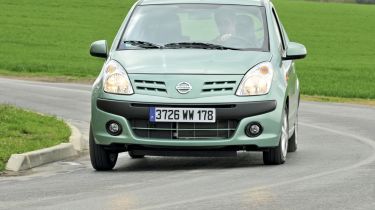Nissan Pixo
New city car is cheapest model in Nissan's range... Will it be the talk of the town?

The Pixo shows great forward thinking. By joining forces with Suzuki, Nissan has delivered a new car in an unfamiliar sector. The model is clean and frugal, as the market demands at the moment. But you can’t get away from the fact that this is an Alto in Nissan clothing. Had bosses given it a proper makeover, they could have been on to a real winner!
If you rate yourself as an expert car spotter, you’re probably already wondering why this Suzuki Alto has a Nissan badge. In fact, this is the all-new Pixo – and it’s the first product of a partnership between Nissan and Suzuki.
Independent car development has become an expensive luxury, so the firms have joined forces to cut costs. The Pixo will be the first Nissan city car to be sold here when it arrives in June. It’s also the first model from the brand to wear the Pure Drive badge – reserved for the most frugal variants in the range.
As well as sharing most of its design and engineering with the Alto, the Pixo is built at the same plant in Delhi, India. Nissan has tried to emphasise the differences between the cars, but apart from the grille, headlights and bumpers, there is little to tell them apart.
Used - available now

2023 Ford
Focus
13,377 milesManualPetrol1.0L
Cash £17,989
2022 Ford
Focus
8,380 milesManualPetrol1.0L
Cash £19,236
2021 Ford
Focus
21,356 milesManualPetrol1.0L
Cash £16,555
2023 Ford
Kuga
25,148 milesManualPetrol1.5L
Cash £19,440Inside, the Pixo doesn’t exactly inspire, although it’s neat and tidy. The fabric-trimmed seats are comfortable but plain, and the centre console, dash and door trims have all been finished with cheap plastics.
While there’s plenty of room up front, passengers aren’t likely to enjoy travelling far in the rear. Hinged windows and limited legroom make for an uncomfortable experience. Plus, the boot is small, offering only 129 litres of space.
The similarities to the Alto come to the fore again out on the road. The top-of-the-range Tekna model we drove was fitted with the four-speed automatic gearbox, a £910 option that’s also available on the Acenta. It's good value for money, but its also worth pointing out that the same option is also available from Suzuki's Alto, priced only £600.
The Pixo is primarily a city car, and despite the auto’s sluggish and delayed responses, its tiny footprint and simple driving experience mean it’s great for getting around busy towns.
Power comes from the same 67bhp 1.0-litre petrol engine as used in the Alto. It propels the manual model from 0-60mph in around 14 seconds, but the longer ratios of our self-shifter turned the dash into a crawl.
The auto took 17 seconds to complete the benchmark sprint – and it felt like it. Things don’t really improve once you’re up to speed. In fourth gear, it seems as if the engine is struggling no matter how many revs it’s pulling. And when you reach a corner, body roll is as much of an issue as it is in the Alto, while the steering offers little in the way of feedback.
Bumpy surfaces are a real challenge for the bouncy ride, too. When the Pixo hits dealers here, three variants will be offered. For a great-value £5,995, the entry-level Visia gets ABS, a CD player and front airbags as standard – but not a lot else.
Pay an extra £750, and the mid-range Acenta adds central locking, folding rear seats, electric windows and
side airbags. Spend a further £900, and the Tekna comes with air-conditioning, curtain airbags and an ESP stability system.
Grabbing all the headlines, though, will be the sub-£6,000 Pixo. Not only will it be the cheapest car Nissan sells, it also promises the lowest running costs of any model from the firm. The manual version of the Visia returns an impressive 64.2mpg and emits 103g/km of CO2.
There’s also talk of an even cleaner stop-start variant, producing 95g/km – so with the Pixo, Nissan is certainly making a bold statement to the rest of the industry.
Rival: Peugeot 107
As well as offering cheeky looks, a roomy cabin and strong residuals, the 1.0-litre 107 can return up to 62mpg. While there is no sub-£6,000 Pixo-rivalling variant, the little Lion is an appealing budget choice.







